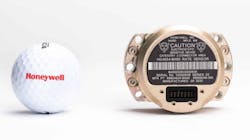Miniature rad-hard inertial sensors for space to help small satellites navigate introduced by Honeywell
PHOENIX – Honeywell Aerospace in Phoenix is introducing the HG4934 rate sensors to help small satellites navigate increasingly crowded orbits above the Earth's surface.
The micro-electromechanical system (MEMS)-based product can reduce cost and power consumption in a smaller size, all while maintaining high levels of performance - an ideal fit for customers building smaller and lower-cost satellites.
At 145 grams, Honeywell's HG4934 space rate sensor is roughly the same size and weight as a baseball. It consumes about one-fifth the amount of electric power, and it is more than 32 times lighter and 60 times smaller than Honeywell's current offerings.
It also is more tolerant of radiation -- a key attribute in space, and uses Honeywell's sensor technology.
A space rate sensor, also known as an inertial reference unit or IRU, is composed of three gyroscopes that work together to sense rotation rates. They determine an aircraft or spacecraft's change in rotational attitude over time and enable it to move from one location to another without using any external information. It also can serve as a backup to provide extra redundancy in case other navigation systems fail.
Celestial navigation options like star trackers are a popular method of obtaining pointing directions for satellites and spacecraft. This form of navigation uses angular measurements between objects in space like stars and plants, and the horizon to calculate location.
Related: Navigation and guidance meets sensor fusion
However, sometimes these star trackers are blinded by the sun or affected by thruster gases. In this case, Honeywell's HG4934 can act as a secondary method of attitude determination.
Honeywell's HG4934 space rate sensor is available now for commercial, defense, and science applications, and first deliveries to customers began at the end of 2020.
For more information contact Honeywell Aerospace online at https://aerospace.honeywell.com.

